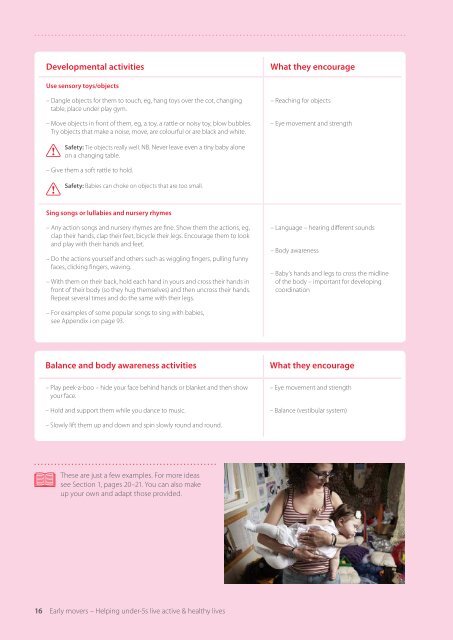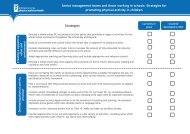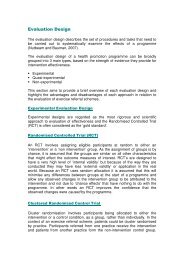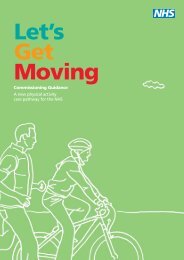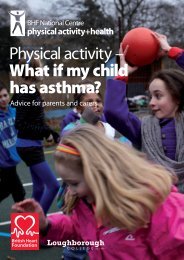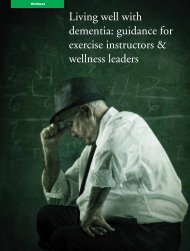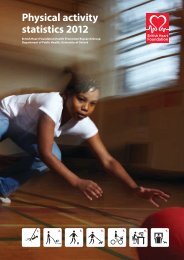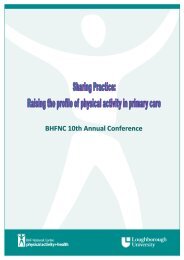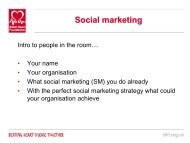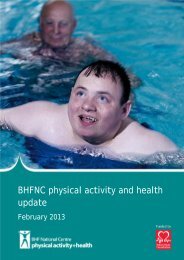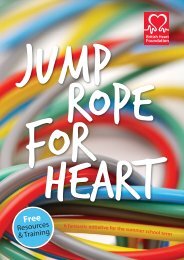5 Practical ideas for physically active play - BHF National Centre ...
5 Practical ideas for physically active play - BHF National Centre ...
5 Practical ideas for physically active play - BHF National Centre ...
- No tags were found...
Create successful ePaper yourself
Turn your PDF publications into a flip-book with our unique Google optimized e-Paper software.
Developmental activitiesUse sensory toys/objectsWhat they encourageResources to encouragethe activitiesProgress in physicaldevelopment– Dangle objects <strong>for</strong> them to touch, eg, hang toys over the cot, changingtable, place under <strong>play</strong> gym.– Reaching <strong>for</strong> objects– Move objects in front of them, eg, a toy, a rattle or noisy toy, blow bubbles.Try objects that make a noise, move, are colourful or are black and white.Safety: Tie objects really well. NB. Never leave even a tiny baby aloneon a changing table.– Give them a soft rattle to hold.Safety: Babies can choke on objects that are too small.Sing songs or lullabies and nursery rhymes– Any action songs and nursery rhymes are fine. Show them the actions, eg,clap their hands, clap their feet, bicycle their legs. Encourage them to lookand <strong>play</strong> with their hands and feet.– Do the actions yourself and others such as wiggling fingers, pulling funnyfaces, clicking fingers, waving.– With them on their back, hold each hand in yours and cross their hands infront of their body (so they hug themselves) and then uncross their hands.Repeat several times and do the same with their legs.– For examples of some popular songs to sing with babies,see Appendix i on page 93.– Eye movement and strength– Language – hearing different sounds– Body awareness– Baby’s hands and legs to cross the midlineof the body – important <strong>for</strong> developingcoordination– Toys that <strong>play</strong> music and make sounds– Colourful mobiles– Teething toys– Unbreakable mirrors– Cloth or board books– Black and white patterns– Rattles– Variety of soft toys with different textures– Lullaby CDs– Nursery rhyme booksThe physical skills/movements that babies 0–3months may be able to do are:– raise their head momentarily while they’re ontheir tummy– move their arms and legs but not control them– see an adult’s face and follow it with their eyes– react to sounds.But babies develop at their own rate, and intheir own ways. This isn’t a definitive list ofdevelopment milestones, and isn’t intended asa checklist <strong>for</strong> you to assess the young childrenin your care.The Early Years Foundation Stage in England andthe Welsh Foundation Phase Curriculum provideguidance on progress in physical development.For more in<strong>for</strong>mation, see Section 1, page 23.Balance and body awareness activitiesWhat they encourage For more in<strong>for</strong>mation on physical development,see Section 1, page 19.– Play peek-a-boo – hide your face behind hands or blanket and then showyour face.– Eye movement and strength– Hold and support them while you dance to music.– Balance (vestibular system)– Slowly lift them up and down and spin slowly round and round. These are just a few examples. For more <strong>ideas</strong>see Section 1, pages 20–21. You can also makeup your own and adapt those provided.16 Early movers – Helping under-5s live <strong>active</strong> & healthy livesSection 5 – <strong>Practical</strong> <strong>ideas</strong> <strong>for</strong> <strong>physically</strong> <strong>active</strong> <strong>play</strong> 17


